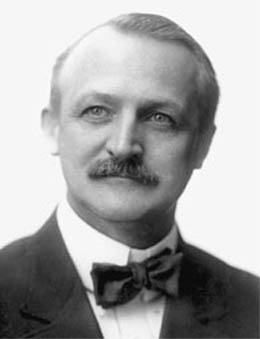On May 29, 1911, Washington Governor Marion E. Hay (1865-1933) tours the newly created Pend Oreille County in the state's far northeastern corner. Hay's tour takes him from Newport to Metaline Falls, with receptions in Dalkena, Usk, Cusick, Ione, and Metaline Falls. His day ends with a banquet at Newport's newly completed Martin's Hotel.
Hay's tour slightly preceded the June 8, 1911, date on which the law creating Pend Oreille county became effective. Pend Oreille was the last of Washington's 39 counties to be formed. The Spokesman-Review covered Hay's trip through what the paper's headline writers called "the baby county" (p. 10).
Hay began the day in Spokane, departing at 7:30 a.m. on an Idaho & Washington Northern Railroad train. The Spokesman-Review called Hay's conveyance "the regular train," indicating that it was not a so-called Special (a train dedicated to a specific party or purpose, such as carrying VIPs). With Hay were State Senator Albert W. Anderson (b. 1871), who would represent Pend Oreille County in the next legislative session and who had been a key supporter of the county's enabling legislation; Fred W. Dewart (b. 1868), E. F. Wagoner, and George J. Mohler, all of Spokane; and John D. Bassett (b. 1858), a bank president from Ritzville.
Spirit Lake, Idaho
The train ran east from Spokane and crossed the Idaho border. The first stop was Spirit Lake, Idaho, where the party detrained and walked into town. Spirit Lake was a recent settlement that had sprung up around timber magnate Frederick A. Blackwell's (1852-1922) Panhandle Lumber Company. Blackwell owned 65,000 acres in Pend Oreille County and was a powerful economic force in the region. His son, Russell Blackwell (1879-1953), who was vice-president and general manager of the railroad on which the governor's party was traveling, and a bevy of Panhandle Lumber's executives greeted Hay and company at Spirit Lake.
At 9:15 the train (which from this point on was designated as a Special, according to The Spokesman-Review) carrying Hay and his party departed, crossing back into Washington and stopping briefly at Newport, where reception committees from the Pend Oreille County towns of Ione, Usk, Cusick, and Newport came on board.
Dalkena, Usk, and Cusick
The train next stopped at Dalkena, where local ranchers and the employees of the Dalkena Lumber Company were waiting. The mill closed down for 15 minutes to give the employees a chance to meet the governor, who (The Spokesman-Review reported) "was heartily cheered."
While at Dalkena, Hay met pioneer and civil war veteran G. O. Brackett, who had recently deeded his ranch to the new county for use as a future home for the indigent and infirm.
The next stop was Usk, and two miles later, Cusick. "The greeting was noisy," reported The Spokesman-Review, "the governor's salute of 13 guns being fired by blasting stumps on a tract of ground being cleared for a park adjoining the railroad. A short auto trip around the town for the governor completed the visit to Cusick and the train departed with another noisy salute from the stump blowers."
Ione
After a 32-mile journey north paralleling the Pend Oreille River, Hay and his party reached Ione. The townspeople had festooned their buildings with bunting, and a band (described by the Spokane paper as "newly organized") was waiting at the depot. Uniformed Boy Scouts escorted the visitors to the home of County Commissioner Lindsay L. Matthews (b. 1866) for lunch. This was followed by a public meeting in Blackwell Hall, where the crowd included the Boy Scouts and Ione's troop of Girl Guides. (This Girl Guide troop and another in Spokane were apparently direct offshoots of the Boy Scouts, possibly the first in the United States. The Girl Scouts of America was not founded until March 12, 1912, in Savannah, Georgia.)
The whistle of the Panhandle Lumber Company's Ione mill was silenced until 1:30, so that mill employees could attend the meeting. The electric mill, first of its kind in the Inland Northwest, cut 250,000 feet of lumber each day. Hay and his party toured the mill after the meeting concluded.
Box Canyon, Metaline Falls, and Back to Newport
Back on board, the party continued on through Box Canyon, where the train paused on the 140-foot railroad bridge so Hay could take in the view. A large crowd was waiting in Metaline Falls. Hay made his way to the porch of the Washington Hotel, and from there addressed the gathering. With his party he then toured the Inland Portland Cement Company. They retrained for the return trip to Newport, arriving back at the depot at 6:15.
"A great crowd was assembled," reported The Spokesman-Review. "Automobiles took the party for a trip around the town and to Silver Birch heights, where a model farm was redeemed from the stumps." A banquet for 150 at the New Martin Hotel followed. The New Martin had been open less than a month. The feast included fillet of sole, sliced turkey and sliced chicken, sugar-cured ham, shrimp salad, Parker House rolls, and strawberry ice cream, among other treats.
The Newport Miner called the banquet "a fitting close to a day of marked enjoyment ... Governor Hay had not anticipated a speech-making tour, and was only prevailed upon to make the short talks on the trip after considerable persuasion. He wanted to see the new county and meet its people face to face ... [and] has formed the most agreeable impression of the new county, and marveled at its variety of resources and character of the great industrial enterprises set on foot here" (quoted in Bamonte, p. xv).
Governor Hay spent the night in Newport, departing the next morning as the new county's commissioners met to decide who they would appoint to county offices when Pend Oreille County was officially organized on June 10, 1911.

